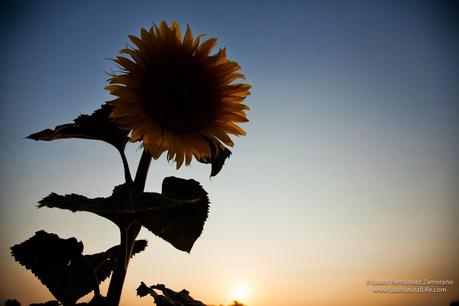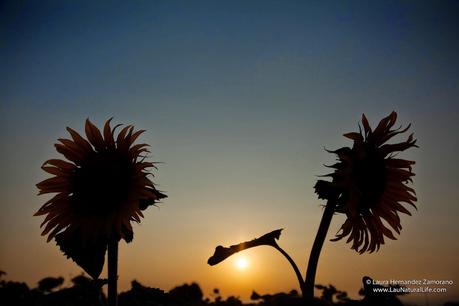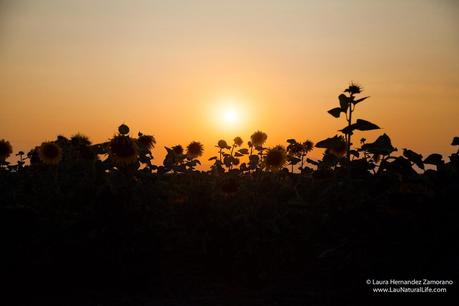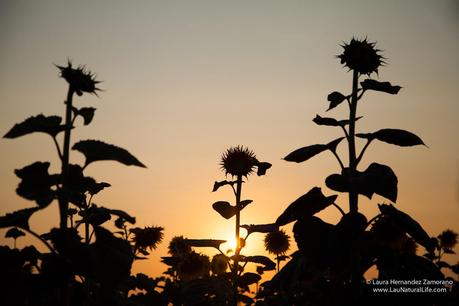En muchas ocasiones no nos damos cuenta que un mismo motivo puede ser captado de maneras muy diversas. Hay que intentar dominar todas las técnicas fotográficas y ser originales, en nuestro archivo de imágenes debemos tener todo tipo de fotografías.
 Como toda sesión fotográfica, antes de la misma, debemos hacer una búsqueda del escenario adecuado, haremos un estudio de nuestro entorno, de enclaves cercanos y que nos puedan aportar algo a nuestra salida fotográfica.
Como toda sesión fotográfica, antes de la misma, debemos hacer una búsqueda del escenario adecuado, haremos un estudio de nuestro entorno, de enclaves cercanos y que nos puedan aportar algo a nuestra salida fotográfica. En nuestro caso, encontramos unos campos de girasoles, y planeamos una salida a los mismos. Por las fechas en que nos encontramos, en esta zona de La Mancha, no están en su mejor momento, pero esto no significa que no podamos hacer fotos. Optamos entonces por ir por la tarde, cuando el sol está cayendo, antes de su puesta, y practicamos el contraluz.
 El contraluz es una iluminación especialmente expresiva, y que a veces no resulta fácil practicarla. El contraluz nos permite resaltar el contorno del motivo, representando una silueta negra con la luz que viene a sus espaldas. En mucho manuales de fotografía se dice que no hay que fotografiar de frente al sol, y si es cierto que dicha técnica puede ser complicada porque hay que medir correctamente la exposición puesto que el sol es muy luminoso y hay que sobreexponerlo para obtener la adecuada exposición en el resto de la escena. Pero esto no significa que no haya que practicarla, los resultados pueden ser sorprendentes!
El contraluz es una iluminación especialmente expresiva, y que a veces no resulta fácil practicarla. El contraluz nos permite resaltar el contorno del motivo, representando una silueta negra con la luz que viene a sus espaldas. En mucho manuales de fotografía se dice que no hay que fotografiar de frente al sol, y si es cierto que dicha técnica puede ser complicada porque hay que medir correctamente la exposición puesto que el sol es muy luminoso y hay que sobreexponerlo para obtener la adecuada exposición en el resto de la escena. Pero esto no significa que no haya que practicarla, los resultados pueden ser sorprendentes! 
Algo a tener en cuenta, es el efecto "flare". Los rayos solares o de cualquier fuente luminosa artificial potente, entran en el objetivo con una inclinación determinada y por el proceso de refracción de la luz entre las lentes internas, creando círculos luminosos en la imagen, que pueden llegar a ser molestos. Para evitarlos, podemos usar un parasol. Pero como todo, sabiendo "jugar" con ellos, pueden ser interesantes en nuestra composición.

Por lo tanto el contraluz no representa tanto riesgo, si no que nos aporta una solución altamente interesante. Para ello, mediremos la luz y la expondremos en zonas luminosas, obteniendo así el efecto de una figura oscura sobre el fondo.
Many times we do not realize that one reason may be captured in many ways. Try to master all photographic techniques and be original in our archive of images we have all kinds of pictures.
As every photo shoot before it, we can search the correct scenario, we will study our environment, nearby enclaves and that we can contribute something to our photographic output.
In our case, we found some sunflower fields, and plan a way out of them. For dates that we are in this area of La Mancha, are not at their best, but that does not mean we can not take pictures.
Then opted to go in the afternoon, when the sun is falling, before commissioning, and practice the backlight.
The backlight is a particularly expressive lighting, and sometimes not easy to practice. The backlight allows us to highlight the contours of the ground, depicting a black silhouette with the light coming behind her.
In much photography manuals is said not to be photographed in front of the sun, and if it is true that this technique can be tricky because you have to correctly measure exposure as the sun is very bright and you have to overexpose to get the proper exposure in the rest of the scene. But this does not mean you should not practice, the results can be amazing!
Something to keep in mind is the "flare" effect. The sun's rays or strong artificial light source, enter the target with a certain inclination and by the process of refraction of light between the internal lenses, creating luminous circles in the image, which can become annoying. To avoid them, we can use a parasol. But like everything, knowing "play" with them, they can be interesting in our composition.
Therefore backlight is not much risk, but it gives us a highly interesting solution. To do this, we will measure the light and will discuss in bright areas, obtaining the effect of a dark figure on the merits.

